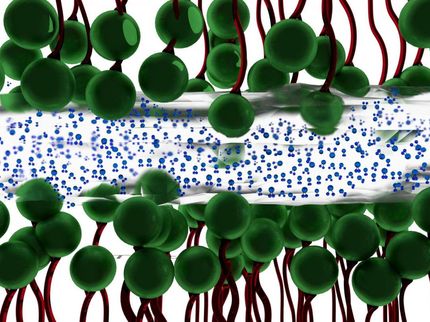Munich lab demonstrates diesel truck engine with barely measurable emissions
Just three months after the Euro 5 Norm for exhaust emissions went into force for all new car models, researchers at the Technische Universitaet Muenchen (TUM) have demonstrated an engine that is already close to meeting the more stringent Euro 6 emissions standard. A research team headed by Prof. Georg Wachtmeister from the Chair of Internal Combustion Engines has succeeded in reducing the pollutants in exhaust emissions to barely measurable levels. The TUM engineers have also developed a probe that allows them to take samples directly from the combustion chamber while the engine is running. With this method they hope to discover precisely how soot forms, with the aim of developing new methods for emissions control.
In a hall at the TUM Chair of Internal Combustion Engines (LVK) the smell of exhaust fumes is barely discernable, even though the two-ton LVK research engine is running at full power. The engine is the centerpiece of the research project NEMo (Niedrigst-Emissions-LKW-Dieselmotor), the German acronym for "lowest emission truck diesel engine." The researchers want to design and fine-tune their engine so that it complies with the Euro 6 caps – without resorting to a catalytic converter.
The Euro 6 Norm, scheduled to come into force by 2014, is a tough standard by any measure. The directive stipulates emission levels that are barely measurable. A diesel engine, for instance, may emit a mere 5 milligrams of soot particles and 80 milligrams of nitrogen oxides per kilometer. That is a fifth of the soot and a quarter of the nitrogen oxides allowed by the Euro 4 Norm that was valid until August, and less than half of the nitrogen oxides permitted by the Euro 5 Norm.
However, a reduction in emissions is complicated by the fact that nitrogen oxides and soot particles cannot be reduced independently of each other.
Nitrogen oxides are formed in an engine when diesel fuel burns in the air of the combustion chamber. Air consists of 21 percent oxygen and 78 percent nitrogen. Diesel fuel reacts with oxygen, producing carbon dioxide and water. This happens in a very fast reaction resulting in combustion chamber temperatures so high that the oxygen also starts to react with the nitrogen in the air, forming nitrogen oxides.
To combat this effect, modern diesel engines recirculate part of their exhaust back into the combustion chamber after cooling it down, together with the fresh air. In this mixture, carbon dioxide and water from the exhaust gases moderate the combustion process, keeping the temperature in check. As a result, fewer nitrogen oxides are formed, albeit at the price of increased soot production since the proportion of oxygen in the air-exhaust mixture is lower.
The TUM researchers designed the LVK test engine in such a way that the air-exhaust mixture is injected into the combustion chamber under high pressure. The engine's turbo-charger compresses the mixture to ten times atmospheric pressure (measured in bar) – more than double the pressure mass-production vehicle engines can handle. Compressed in this way, the air-exhaust mixture contains enough oxygen for the diesel fuel to burn completely.
They coupled this innovation with another improvement, at the nozzle that injects diesel fuel into the combustion chamber. It atomizes the fuel into microscopic droplets, allowing them to burn completely. In larger droplets produced by conventional injectors, only the outer layer of fuel molecules are burned, like an onion whose first layer has been peeled. The resulting exhaust fumes envelop the fuel droplets, shielding them from the oxygen. The shell of exhaust gases gets increasingly dense with each "onion layer" that goes up in flames. Eventually it becomes practically impossible for oxygen to react with the fuel. The result: soot formation.
The NEMo injector nozzle atomizes diesel fuel at a pressure of over 3000 bar – standard is 1800 bar, at most – to generate a fuel mist that burns very quickly and practically soot-free. Unfortunately, this also results in surging temperatures; a tricky situation, and finding the right balance between the three parameters of exhaust gas recirculation, boost pressure, and nozzle configuration proved challenging indeed.
Yet the engineers at the Chair of Internal Combustion Engines at the TUM are not content with fulfilling the Euro 6 Norm. They want to find out precisely how soot is formed in the split seconds during which the fuel droplets burn up. Simply placing a probe in the combustion chamber would disturb the combustion process. To surmount this problem the researchers constructed a tiny pipe that is shot into the center of the combustion chamber at lightning speed. The gas-sampling valve needs only one millisecond to take a sample before leaving the combustion chamber again. Using this method, 13 samples can be taken during a single ignition – an ideal situation for studying the growth of soot particles and developing engines with even lower emissions.





















































